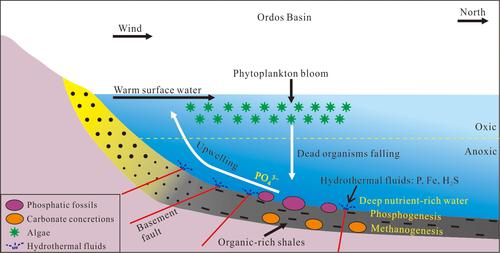当前位置:
X-MOL 学术
›
Acta Geol. Sinica Engl. Ed.
›
论文详情
Our official English website, www.x-mol.net, welcomes your
feedback! (Note: you will need to create a separate account there.)
Origin of Phosphate-bearing Carbonate Concretions in the Upper Triassic Lacustrine Black Shales of the Southern Ordos Basin, China
Acta Geologica Sinica-English Edition ( IF 3.5 ) Pub Date : 2020-01-21 , DOI: 10.1111/1755-6724.14501 Long ZHANG 1, 2, 3 , Chiyang LIU 4 , Dongdong ZHANG 4 , Shaodong QU 5 , Huanhuan MA 4 , Chong JIANG 3 , Kaiyu LEI 6
Acta Geologica Sinica-English Edition ( IF 3.5 ) Pub Date : 2020-01-21 , DOI: 10.1111/1755-6724.14501 Long ZHANG 1, 2, 3 , Chiyang LIU 4 , Dongdong ZHANG 4 , Shaodong QU 5 , Huanhuan MA 4 , Chong JIANG 3 , Kaiyu LEI 6
Affiliation

|
Carbonate concretions are conspicuous in organic-rich shales and are generally related to decomposition of organic matter. The black shales from the Chang 7 Member of the Upper Triassic Yanchang Formation of the southern Ordos Basin host abundant carbonate concretions, which provide a unique record of depositional and early diagenetic conditions of the paleo-lake sediments. However, little attention has been given to the genesis and growth processes of the concretions in these lacustrine petroleum source rocks. New petrographic observations and geochemical analysis show that the concretions are composed of calcite, phosphate fossil fragments, K-NH4-feldspar, quartz, bitumen, and minor Fedolomite. Phosphate minerals, mainly carbonate fluorapatite (CFA), show pervasive replacement by calcite, most of which contains phosphorus, ranging in concentration from 0.26 to 2.35 wt%. This suggests that the phosphate minerals are the precursors for concretion growth. Positive δ13C (+5.6 to +12.4 ‰ V-PDB) signatures and the absence of pyrite indicate that microbial methanogenesis was the dominant driver for concretion growth, rather than bacterial sulfate reduction. Quartz, bitumen, and Fe-dolomite are the last cements that occurred, at deep burial depths and high temperatures. The formation of phosphate minerals might have been induced by upwelling of phosphate-enriched deep water in the Late Triassic paleolake, which promoted phytoplankton blooms and further enrichment of organic matter. Extremely slow sedimentation rates of fine-grained detrital minerals, relative to dead organism accumulation, led to the high permeabilities of the organic-rich sediments and rapid concretion growth during shallow burial. The close association of phosphate-bearing carbonate concretions and organic-rich shales reflects that upwelling played a critical role in the formation of the high-quality petroleum source rocks in the Triassic paleo-Ordos lake.
更新日期:2020-01-21











































 京公网安备 11010802027423号
京公网安备 11010802027423号